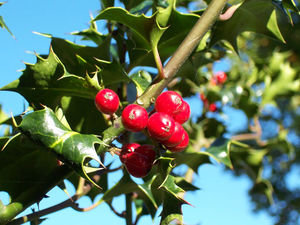Holly
Holly timber is a very hard dense fine grained hardwood, and the whitest of all timber species. Its also felled in many gardens in the UK. The interest in recycling & reuse and the rising price of timber may motivate some to re-use felled wood.
Issues
Holly also has significant issues. First its an unstable type of wood, making it unsuited to many tasks.
Holly also is prone to fungus staining after felling, which is disfiguring. To avoid this it should be dried quickly. Drying is done by completely debarking, and painting the cut ends. This fast drying increases the risk of splitting.
The final issue is that most garden felled hollies are small. This much limits the possible applications, but in the case of holly even very small trunks have their uses.
Uses
Holly is used as a near white inlay veneer, where its lightness is unmatched by any other wood.
Its also a good wood for turning, with its fine grain and toughness taking detail very well, and its eye catching colour.
It can also be used in non-critical tasks where when its lack of stability is acceptable. Its high strength makes even very small trunks usable in the round for some applications.
Lastly Twig Furniture can be made from the tough twigs, for those that wish to.
History
Historically holly was used for chariot axles, food skewers and wooden printing blocks, all applications benefitting greatly from its hardness. It was also used in Victorian looms; it sands to a very smooth surface, minimising the risk of thread catching.
Identification
Holly is easily identified by the spiky waxy leaves associated with christmas. Only female trees bear the red berries.
